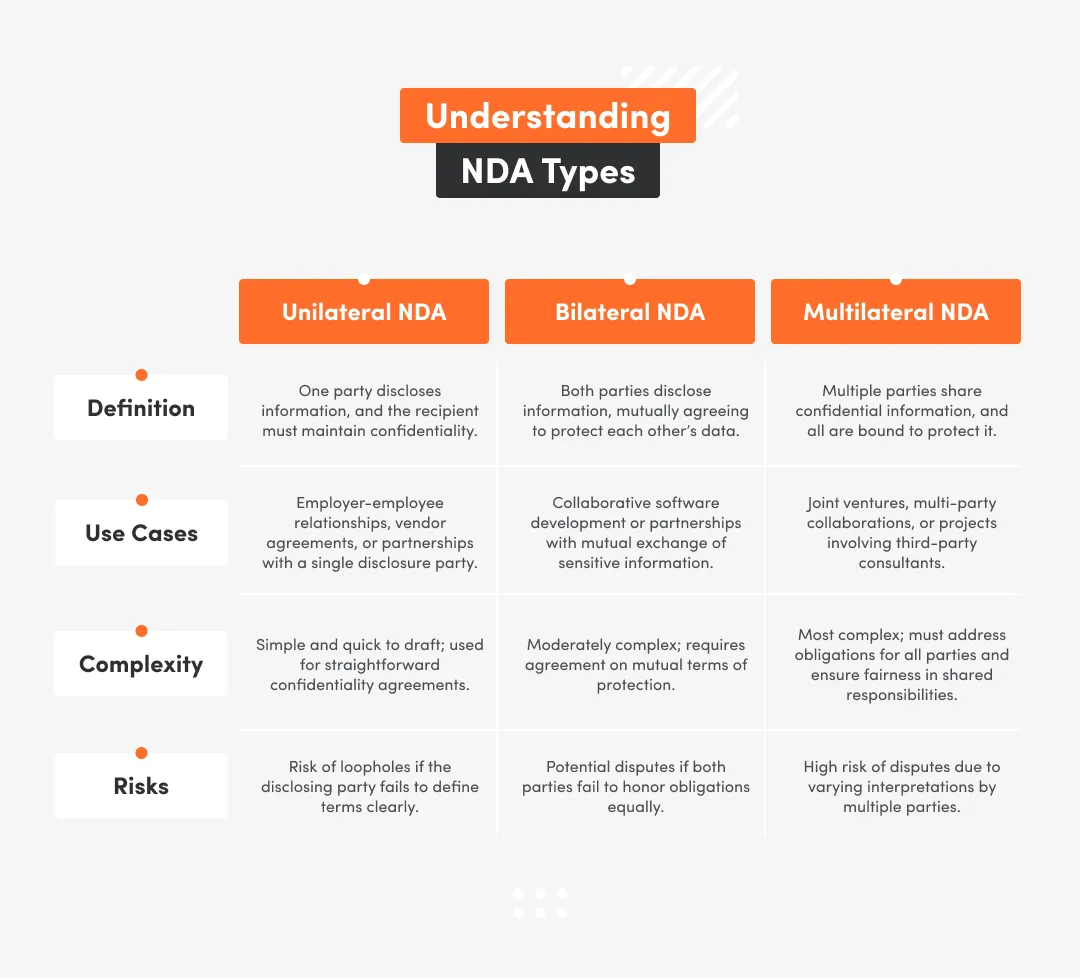In software development, a Non-Disclosure Agreement (NDA) is a crucial legal document that protects sensitive information shared between parties. As businesses increasingly collaborate and innovate, the significance of NDAs grows. These agreements ensure that proprietary information, trade secrets, and other confidential data remain secure, fostering trust among stakeholders.
An NDA creates a confidential relationship between the involved parties, ensuring that sensitive information shared during the software development process is protected. This is vital for maintaining a competitive edge, as unauthorized disclosure of sensitive data can lead to significant disadvantages or legal disputes.
Moreover, the integration of Artificial Intelligence (AI) into NDA management is changing how these agreements are drafted, reviewed, and enforced. AI tools improve efficiency, accuracy, and compliance, allowing businesses to streamline their contract management processes.
In addition to protecting intellectual property, NDAs help maintain the secrecy of valuable data, which is crucial in a competitive market. Using NDA templates can simplify the drafting process, allowing businesses to customize agreements to fit their specific needs while ensuring legal compliance.
The Purpose and Benefits of Using NDAs
Non-Disclosure Agreements (NDAs) are vital legal tools that protect sensitive information shared between parties, especially in software development. The main purpose of an NDA is to create a confidential relationship, ensuring that proprietary information, trade secrets, and other confidential data remain secure. This is crucial for fostering trust and collaboration among businesses, particularly when innovative ideas and intellectual property are at stake. NDAs are particularly important in the context of AI and machine learning, where traditional definitions of confidentiality may be challenged.
In the software development sector, NDAs are essential for protecting intellectual property and maintaining a competitive edge.
They help prevent unauthorized disclosure of sensitive data, which could lead to significant competitive disadvantages or legal disputes. Key elements of an NDA include definitions of confidential information, obligations of the receiving party, the duration of confidentiality, and the consequences of breach. By clearly outlining these aspects, NDAs ensure that all parties understand their responsibilities, minimizing the risk of information leaks.
Moreover, NDAs can be categorized into unilateral, bilateral, and multilateral agreements, each serving different purposes based on the nature of the information shared. For instance, a unilateral NDA involves one party disclosing information to another, with only the recipient bound by confidentiality. This type is common in employer-employee relationships, where sensitive company information is shared with employees.
As businesses increasingly rely on technology, the integration of Artificial Intelligence into NDA management is transforming how these agreements are drafted, reviewed, and enforced. AI tools enhance efficiency and compliance, allowing legal teams to focus on strategic initiatives rather than routine tasks.
Key Components of an NDA for Software Development

A Non-Disclosure Agreement (NDA) is a vital legal instrument in the software development sector, designed to protect sensitive information shared between parties. In an industry where intellectual property and innovative ideas are paramount, NDAs serve as a safeguard against unauthorized disclosure and misuse of confidential data. They ensure that proprietary information, trade secrets, and business strategies remain secure, fostering trust and collaboration among stakeholders. NDAs must evolve to address the challenges posed by emerging technologies like AI and machine learning, which can complicate traditional definitions of confidentiality.
Key components of an NDA include:
- Definitions of Confidential Information: Clearly outlining what constitutes confidential information is crucial. This can include software code, algorithms, business plans, and customer data. By specifying these details, parties can avoid misunderstandings about what information is protected.
- Obligations of the Receiving Party: The NDA should detail the responsibilities of the party receiving confidential information. This includes how they must handle the information, restrictions on sharing it with third parties, and the measures they must take to protect it.
- Duration of Confidentiality: NDAs typically specify how long the confidentiality obligations will last. This duration can vary based on the nature of the information and the relationship between the parties. For instance, sensitive information may require longer protection periods.
- Consequences of Breach: It is essential to outline the repercussions if either party fails to adhere to the NDA. This can include legal action, financial penalties, or other remedies to ensure compliance and deter breaches.
- Types of NDAs: There are various forms of NDAs, including unilateral, bilateral, and multilateral agreements. The choice of NDA type should align with the specific needs of the parties involved, particularly in software development where information flow can be complex.
Incorporating AI into NDA management is also transforming how these agreements are drafted and enforced. AI tools enhance efficiency and compliance, allowing businesses to streamline their contract management processes. This integration not only speeds up the review process but also provides insights into potential risks associated with the agreements.
Try our developers.
Free for 2 weeks.
No risk. Just results. Get a feel for our process, speed, and quality — work with our developers for a trial sprint and see why global companies choose Selleo.
Types of NDAs in Software Development
Non-Disclosure Agreements (NDAs) play a pivotal role in the software development industry, serving as essential legal contracts that protect sensitive information shared between parties. These agreements are crucial for safeguarding intellectual property, trade secrets, and proprietary information, which are vital for maintaining a competitive edge in a rapidly evolving market. NDAs help prevent unauthorized disclosure of sensitive data, which can lead to significant competitive disadvantages or legal disputes.
There are three main types of NDAs: unilateral, bilateral, and multilateral. A unilateral NDA involves one party disclosing information to another, with only the recipient bound by confidentiality. This type is commonly used in employer-employee relationships, where the employer shares sensitive information with the employee. In contrast, a bilateral NDA (or mutual NDA) is used when both parties share confidential information, ensuring that both are legally bound to protect each other's data.
Lastly, a multilateral NDA involves three or more parties, where at least one party discloses information to others, and all parties are bound by confidentiality obligations. This type is often used in joint ventures or collaborations where multiple entities share sensitive information.
Key elements of an NDA include definitions of confidential information, obligations of the receiving party, the duration of confidentiality, and the consequences of breach. These elements are crucial for ensuring that all parties understand their responsibilities and the scope of the agreement. Additionally, the integration of AI in NDA management is transforming how these agreements are drafted, reviewed, and enforced.
Drafting an Effective NDA for Software Development

Drafting an effective Non-Disclosure Agreement (NDA) is essential for any software development project. An NDA serves as a legal contract that establishes a confidential relationship between parties, ensuring that sensitive information shared during the development process remains protected. This is particularly crucial in the software industry, where intellectual property, trade secrets, and proprietary information are at stake.
When drafting an NDA, it is important to include several key elements:
- Definitions of Confidential Information: Clearly outline what constitutes confidential information. This can include source code, algorithms, business strategies, and any other sensitive data that needs protection.
- Obligations of the Receiving Party: Specify the responsibilities of the party receiving the confidential information. This includes how they should handle the information and the measures they must take to protect it.
- Duration of Confidentiality: Determine how long the confidentiality obligations will last. This can vary depending on the nature of the information and the relationship between the parties.
- Consequences of Breach: Clearly state the repercussions if the NDA is violated. This can include legal action, financial penalties, or other remedies.
In the context of software development, NDAs can be either unilateral or mutual. A unilateral NDA involves one party disclosing information to another, while a mutual NDA allows both parties to share confidential information. Understanding the type of NDA that best fits your situation is crucial for effective protection.
Moreover, the integration of AI into NDA management is transforming how these agreements are drafted and enforced. AI tools enhance efficiency and compliance, allowing businesses to streamline their contract management processes. This is particularly relevant in a fast-paced industry where the safeguarding of sensitive information is paramount.
Legal Considerations and Enforceability
Non-Disclosure Agreements (NDAs) are essential legal instruments that establish a confidential relationship between parties, particularly in the software development industry. They serve to protect sensitive information, intellectual property, and trade secrets, ensuring that proprietary data remains secure and fostering trust among collaborators. As businesses increasingly rely on technology and innovation, the enforceability of NDAs has become more critical than ever.
In the context of software development, NDAs are vital for safeguarding innovative ideas and proprietary information. They help prevent unauthorized disclosure, which can lead to competitive disadvantages or legal disputes. NDAs must explicitly address the challenges posed by artificial intelligence (AI) and machine learning (ML), as these technologies are reshaping traditional definitions of confidentiality. This evolution necessitates that NDAs clearly outline the obligations of the parties involved, including definitions of confidential information, the duration of confidentiality, and the consequences of breach.
There are different types of NDAs, including unilateral, bilateral, and multilateral agreements. A unilateral NDA involves one party disclosing information to another, with only the recipient bound by confidentiality. This type is common in employer-employee relationships. In contrast, bilateral NDAs involve mutual sharing of confidential information, making both parties responsible for safeguarding the data. Understanding the nuances of these agreements is crucial for businesses to maintain their competitive edge and protect their interests in a highly competitive market.
The integration of AI into NDA management is transforming how these agreements are drafted, reviewed, and enforced. AI tools enhance efficiency and compliance, allowing businesses to streamline their contract management processes. AI-driven systems can process and analyze contracts at unprecedented speeds, significantly accelerating negotiations and closing deals. This technological advancement not only improves the accuracy of NDA management but also mitigates risks associated with human error.
Moreover, using NDA templates can simplify the drafting process, ensuring that businesses customize agreements to fit their specific needs while remaining compliant with legal standards.
Best Practices for Implementing NDAs in Software Development
Non-Disclosure Agreements (NDAs) are essential legal instruments in the software development industry, serving as a protective barrier for sensitive information shared between parties. These agreements are crucial for safeguarding intellectual property, trade secrets, and proprietary data, which are vital for maintaining a competitive edge in a rapidly evolving market. NDAs not only foster trust and collaboration but also explicitly address the challenges posed by emerging technologies like AI and machine learning.
When implementing NDAs in software development, it is important to consider several best practices to ensure their effectiveness. First, clearly define what constitutes confidential information. This includes not only the software code and algorithms but also business strategies, client lists, and any other sensitive data that could be detrimental if disclosed. A well-structured NDA should outline the obligations of the receiving party, the duration of confidentiality, and the consequences of any breach.
Another best practice is to determine the type of NDA that best suits the relationship between the parties involved. NDAs can be unilateral, where only one party discloses information, or mutual, where both parties share confidential information. This distinction is crucial in ensuring that both parties understand their responsibilities and the scope of confidentiality.
Moreover, leveraging technology can enhance the NDA management process. The integration of AI in NDA reviews allows for faster processing and analysis of contracts, ensuring compliance and reducing the risk of human error. AI tools can automate routine tasks, enabling legal teams to focus on more strategic initiatives while providing insights into contract trends and risks.
Common Mistakes to Avoid in Software Development NDAs

In the realm of software development, Non-Disclosure Agreements (NDAs) play a pivotal role in safeguarding sensitive information. However, many organizations make critical mistakes when drafting or implementing these agreements, which can lead to significant legal and financial repercussions. Here are some common pitfalls to avoid when creating NDAs.
Neglecting to Define Confidential Information
One of the most frequent errors is failing to clearly define what constitutes confidential information. An NDA should explicitly outline the types of information that are protected, such as trade secrets, proprietary data, and intellectual property. Without this clarity, the agreement may be deemed unenforceable.
Using Incomplete or Generic Templates
Many businesses rely on generic NDA templates without customizing them to fit their specific needs. This can lead to omissions of critical clauses or legal requirements. It is essential to tailor the NDA to the unique circumstances of the project and the parties involved.
Overlooking Duration of Confidentiality
Another common mistake is not specifying the duration of confidentiality. NDAs should clearly state how long the information must remain confidential. This duration can vary based on the nature of the information and the industry standards. Failing to include this can lead to confusion and potential breaches of trust.
Ignoring Consequences of Breach
An effective NDA should outline the consequences of breaching the agreement. This includes potential legal actions and financial penalties. By clearly stating these repercussions, parties are more likely to adhere to the terms of the NDA.
Failing to Review and Update Regularly
Lastly, NDAs should not be static documents. As business relationships evolve and new technologies emerge, it is crucial to review and update NDAs regularly. This ensures that they remain relevant and effective in protecting sensitive information.
By avoiding these common mistakes, businesses can better protect their sensitive information and maintain a competitive edge in the software development industry. NDAs are not just legal formalities; they are essential tools for fostering trust and collaboration.
NDA Template for Software Development
A Non-Disclosure Agreement (NDA) is a vital legal document in the software development industry, designed to protect sensitive information shared between parties. As businesses increasingly rely on collaboration and innovation, the importance of NDAs cannot be overstated. They ensure that proprietary information, trade secrets, and other confidential data remain secure, fostering trust and collaboration among stakeholders. In a landscape where intellectual property is paramount, NDAs serve as the first line of defense against unauthorized disclosure and misuse of confidential information.
Importance of NDAs in Software Development
In the software development sector, NDAs are crucial for safeguarding intellectual property and innovative ideas that are essential for maintaining a competitive edge. NDAs help outline the obligations of the parties involved, ensuring that sensitive information is not disclosed or misused. This is particularly important in an era where artificial intelligence (AI) and machine learning (ML) are reshaping traditional definitions of confidentiality and data protection.
Key Elements of an NDA
When drafting an NDA, several key elements must be included:
- Definitions of Confidential Information: Clearly outline what constitutes confidential information to avoid ambiguity.
- Obligations of the Receiving Party: Specify the responsibilities of the party receiving the confidential information, including how they should handle and protect it.
- Duration of Confidentiality: Establish how long the confidentiality obligations will last, which can vary based on the nature of the information shared.
- Consequences of Breach: Detail the repercussions for failing to adhere to the NDA, which can include legal action or financial penalties.
These elements are essential for ensuring that both parties understand their rights and responsibilities, thereby minimizing the risk of disputes.
Types of NDAs

There are three main types of NDAs:
- Unilateral NDA: Involves one party disclosing information to another, with only the recipient bound by confidentiality. This is common in employer-employee relationships.
- Bilateral NDA: Both parties share confidential information and are mutually bound to protect it.
- Multilateral NDA: Involves three or more parties, where at least one party discloses information to others, and all parties are bound by confidentiality.
Choosing the right type of NDA is crucial for ensuring the protection of sensitive information. Using NDA templates can streamline the drafting process, allowing businesses to customize agreements to fit specific needs while ensuring legal compliance.
The Role of AI in NDA Management
The integration of AI into NDA management is transforming how these agreements are drafted, reviewed, and enforced. AI tools enhance efficiency, accuracy, and compliance, allowing businesses to streamline their contract management processes.
In conclusion, NDAs are essential for software developers, clients, and partners to maintain trust and protect their interests in a highly competitive market. By understanding the importance of NDAs and their key elements, businesses can better safeguard their intellectual property and sensitive information, ensuring a secure environment for innovation and collaboration.
Safeguarding Your Software Development Projects
In software development, safeguarding your projects is crucial, and a Non-Disclosure Agreement (NDA) plays a vital role in this process. An NDA is a legal contract that establishes a confidential relationship between parties, ensuring that sensitive information shared during the development process remains protected. This is particularly vital in an industry where intellectual property, trade secrets, and innovative ideas are at stake. By outlining the obligations of the parties involved, NDAs help prevent unauthorized disclosure and misuse of confidential information, fostering trust and collaboration among developers, clients, and partners.
The importance of NDAs cannot be overstated, especially in today's fast-paced digital landscape. NDAs must evolve to address the challenges posed by emerging technologies like AI and machine learning. These technologies are reshaping traditional definitions of confidentiality, making it essential for NDAs to explicitly cover the nuances of data handling and sharing in this new context.
Incorporating AI into NDA management is also transforming how these agreements are drafted, reviewed, and enforced.
This integration not only accelerates the review process but also mitigates risks associated with human error, ensuring that sensitive information remains secure.
Ultimately, using an NDA is essential for software developers and their clients to maintain trust and protect their interests in a highly competitive market. By taking the necessary steps to implement robust NDAs, businesses can safeguard their intellectual property and sensitive data, ensuring that their innovative ideas remain confidential and secure.





